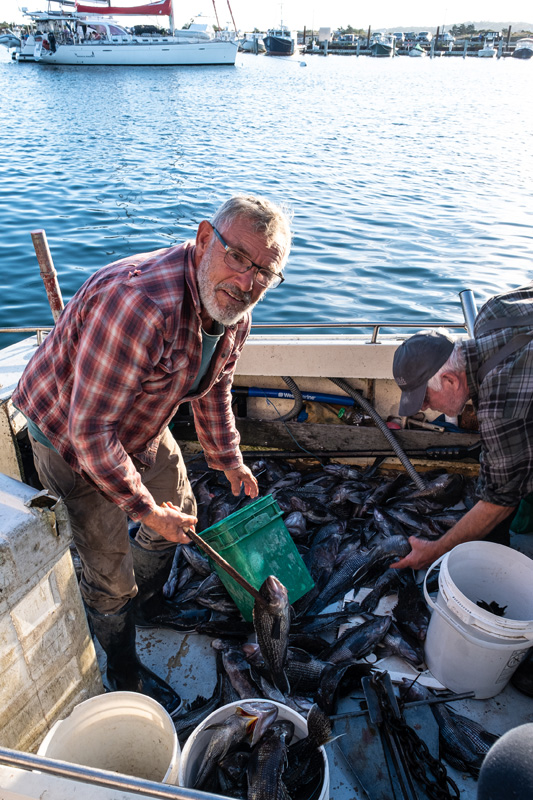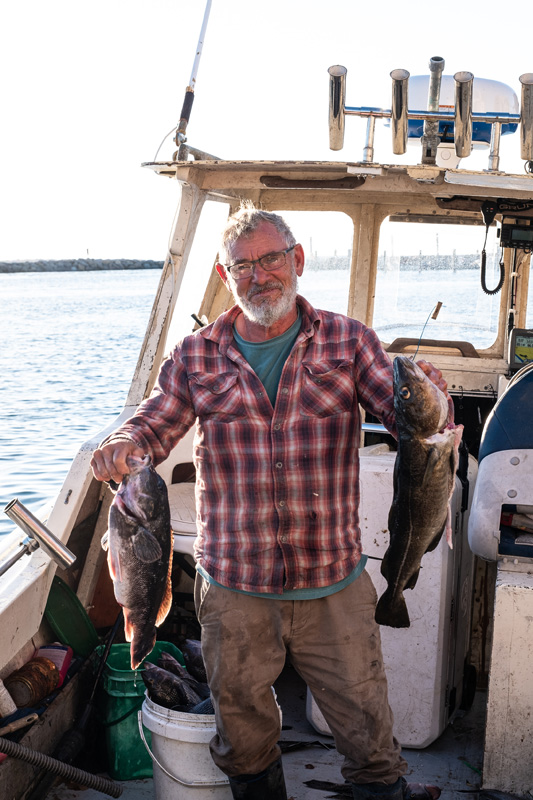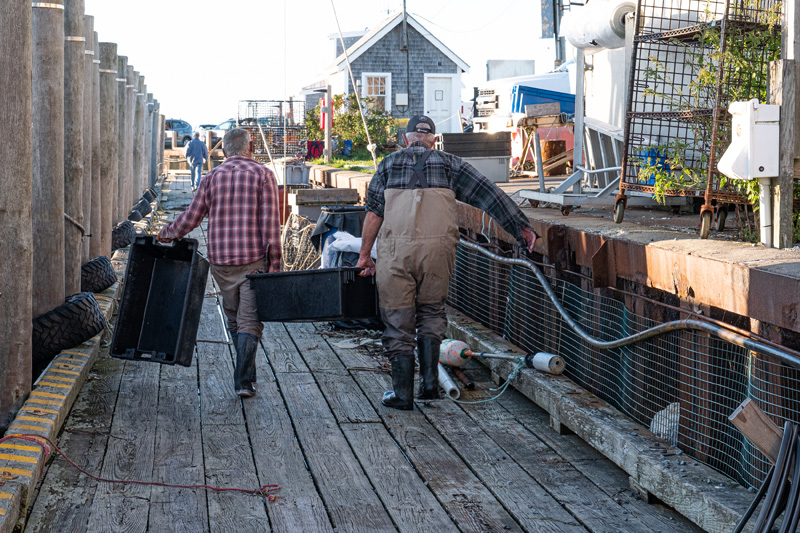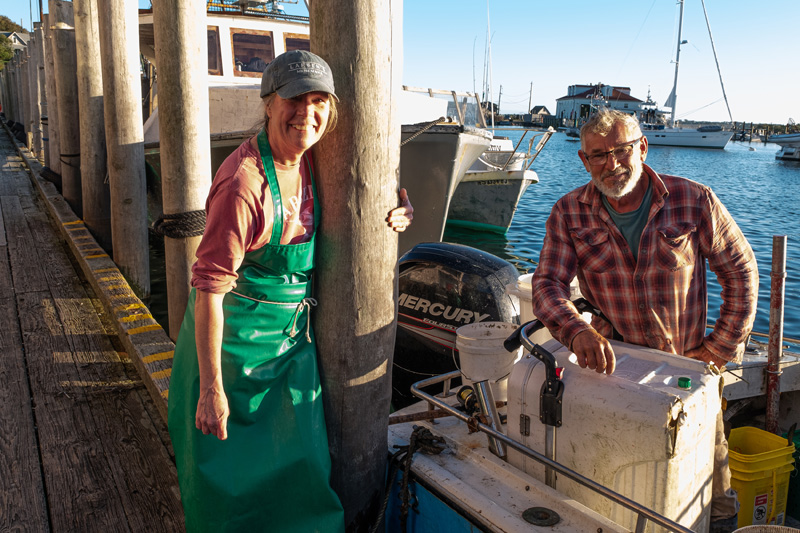Most people on the Island know Johnny Hoy as the frontman for the blues band Johnny Hoy and the Bluefish. What some may not realize is that Hoy is also a commercial fisherman, and when he’s not belting out Muddy Waters tunes, he’s hauling in codfish, tautog, and black sea bass. So we decided to check in with Johnny as the fishing season is winding down, and see what he plans on doing as we head into fall and winter.
In early October, we met up with Hoy and his childhood friend, Jim Tryon, who grew up with Hoy in Glastonberry, Conn., as they were dropping off their catch at Larsen’s Fish Market in Menemsha. It turned out to be a beautiful afternoon, although the water had been churned up considerably, as the remnants of Hurricane Ian had just come through. But Johnny knew enough not to get too comfortable with the weather. As we headed into November, the cold and blustery days would soon outnumber the balmy days of summer, and fishermen like Hoy, who continued fishing into the late fall and winter, knew what they were getting into.
Back in the ’80s, Hoy earned his money from gigging with his band and from doing some construction work and masonry jobs. It didn’t take him long to realize he’d rather be out on the water than sweating in a hot ditch or baking on a roof, and he made the switch to commercial fishing, although he still does the occasional masonry job to make ends meet. “Sometimes you just have to do what you’ve got to do,” he said.

Back in the old days, commercial fishermen were still making good money fishing for blues and striped bass, but these days, Johnny said, “The striped bass fishing is just not the same as it used to be, and these days it’s just not worth it economically, so I find that I concentrate mostly on black sea bass, a delicious white-meat fish. I’m also a big fan of tautog,” Hoy said. Black sea bass have a season that stretches from June into December, and the tautog season is nearly as long.
Johnny’s 22-foot Hi-Liner pulled up to the dock at Larsen’s, and Hoy and Tryon unloaded two coolers of fish, mostly black sea bass, along with some tautog and a few codfish.
I mentioned to Hoy that last Thanksgiving, my daughter, her husband, and their two boys rented a house next to Split Rock on Lambert’s Cove Beach, and the boys were fishing and the waters were thick with black sea bass. Hoy told me the story of an old guy from Saugerties, N.Y., who used to come to the Vineyard and fish for weeks around Split Rock. Hoy would see him at the dock at the end of the day dragging a big, old metal Coca-Cola cooler, looking beat-up, bloody, and exhausted, with all sorts of fish tales hanging out of the cooler. “All the young bucks were out fishing for game fish like blues and stripers,” Hoy said, “and this guy was catching black sea bass, tautog, blackback flounder, and we thought, This guy knows shit about fishing that we don’t even know the half of. He was a big influence on my approach to fishing. The big lesson was to just keep fishing, and even in the off-season, there’s a lot of fish out there.

“Yes, it can get windy and blustery out there in the fall,” Hoy said, “but the fish are still out there. My birthday is on Jan. 10, and I try to get out there for that, and I’ve had some pretty good days, but the problem with fishing late in the season is not that all the fish just dry up, the problem is the lack of people to buy them.” Most people on the Island are summer people, and they head home when it gets cold, so there are not as many people to sell to.
“Fortunately, we’ve got the M.V. Seafood Collaborative,” Hoy said. The collaborative started in 2021, and they ship some of the catch off-Island.
But as the dead of winter hits, and the fishing gets tougher, in addition to playing blues harp with the Bluefish, Hoy has a little boat he uses for oystering, which he can do all winter. He is on the West Tisbury shellfish commission, where he and the other commissioners work on finding the best ways to propagate oysters.
Hoy is also one of three people on the riparian commission that decide when to open up the cut from Tisbury Great Pond, and James Pond, to the ocean. “One thing I’ve learned,” Hoy said, “is that everyone in town has their own theory on opening the cut, and that it’s far more complicated than most people know.”
The basic reason for opening the cut is to increase the salinity level in the pond, which helps shellfish grow, and famously allows female herring to spawn and baby herring in turn to go out to the open ocean. This is done several times throughout the year. “Originally it’s done with an excavator,” Hoy says, but he and a group of guys will also do the laborious job by hand when it starts to fill in.


But it’s not just herring that seek the open ocean. Last July, Hoy saw a small river of baby flounder about an inch long, coming out of a hole behind the beach. It ran for about an hour or so in a solid stream before going out to the ocean.
“There’s a lot of stuff going on we don’t know about,” Hoy said. “I’m always amazed at what’s going on in those ponds.”
Which is why he was taking particular interest in a Supreme Court case that was about to go down in early October. The conservative majority court would begin hearing arguments that lean toward limiting the Environmental Protection Agency’s ability to determine the fate of protected wetlands. “You have to keep your eye on these things,” Johnny said. “We have to do everything we can to protect the environment, because if you don’t, little bits can get chipped away, and every piece of the puzzle impacts all the other pieces, and if we lose too many of the pieces, all of a sudden the whole thing will collapse.” So for fishermen like Johnny Hoy, there’s not only a lot to do in the off-season, there’s a lot to think about as well.


